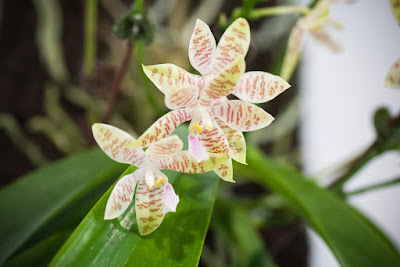The Hieroglyphic Phalaenopsis is native to the Philippine islands of Luzon, Polillo, Palawan and Mindanao. It is found growing on and hanging down from trees in the coolest and deeply shady locations of humid forests at elevations below 1700 feet (500 meters).
Phalaenopsis hieroglyphica orchid, also called as The Hieroglyphic Phalaenopsis, Phalaenopsis hieroglyphica f. flava, Phalaenopsis lueddemanniana subvar. hieroglyphica, Phalaenopsis lueddemanniana var. heiroglyphica, Phalaenopsis lueddemanniana var. palawensi, Phalaenopsis lueddemanniana var. surigadensis, Polychilos hieroglyphica, is a species of the genus Phalaenopsis. This species was described by (Rchb.f) Sweet in 1969.
IDENTIFY PHALAENOPSIS HIEROGLYPHICA ORCHID
The Hieroglyphic Phalaenopsis is native to the Philippine islands of Luzon, Polillo, Palawan and Mindanao. It is found growing on and hanging down from trees in the coolest and deeply shady locations of humid forests at elevations below 1700 feet (500 meters).
It is a medium sized, pendant growing epiphyte with a short stem enveloped by imbricating leaf bases carrying a few to many, somewhat coriaceous, oblong-ligulate, acute to obtuse leaves. The leaves are 30 cm long and leathery.
Phalaenopsis hieroglyphica blooms in the spring on a suberect to arching, 12" (30 cm) long, racemose or paniculate, few (3 to 4) flowered inflorescence with small ovate-cucullate bracts and long-lasting, glossy, showy, simultaneously opening flowers. The star-shaped flowers are 5.0-6.4 cm in diameter and firm texture. The sharp tips of both whorls may overlap at the base. They are white to cream, often with a green tinge on the tips and have red or cinnamon patterns or spots. The lip is white with a pink tint and the prone is yellow.
After the last blossom fades, the stalk remains and will rebloom in subsequent springs if it remains alive and green.
GROW AND CARE PHALAENOPSIS HIEROGLYPHICA ORCHID
Cultural information should only be used as a guide, and should be to be adapted to suit you. Your physical location; where you grow your plants, how much time you have to devote to their care, and many other factors, will need to be taken into account. Only then can you decide on the cultural methods that best suit you and your plants.
Light:
Phalaenopsis hieroglyphica orchid needs a light level of 10000-12000 lux. However, the photoperiod should not be short: it needs 11-12 hours of light at a minimum.
Temperature:
The average temperature of the summer day is 31-32 ° C, the night 23-24 ° C giving a daily difference of 8 ° C. The average temperature of the winter day is 28-29 ° C, night 22-23 ° C, giving a smaller daily difference of 6-7 ° C.
Humidity:
If you grow it in a pot, the humidity of the air is 65-75% are more than enough. In case your orchid is mounted, you need 80-90% minimum.
Substrate, growing media:
Phalaenopsis hieroglyphica has a sloping or hanging habit and grows best mounted on a rootstock, provided that the humidity remains high. In cultivation, plants are healthier if they never dry up completely. If it is necessary to grow in pots, the base is bark. It may be beneficial to add a small amount of limestone, provided that you use warm water for watering. The plants grow sloping in pots.
Watering:
Plants should be constantly moist. It is recommended to use warm water at a temperature of about 21 ° C. Schedule of precipitation is wet/very wet. On sunny days this orchid likes water on the leaves very much. It is better to do it in the first part of the day.
Fertilizer:
It is recommended to apply a weekly or bi-weekly 1 / 4-1 / 2 dose of fertilizer for orchids in the growing season.
Rest period and repotting:
Humidity and precipitation are highest in winter, but in cultivation one should not increase the amount of water in this period, because temperatures are probably slightly lower then.
Repotting is better done in early spring, when new roots begin to grow than after flowering.















COMMENTS